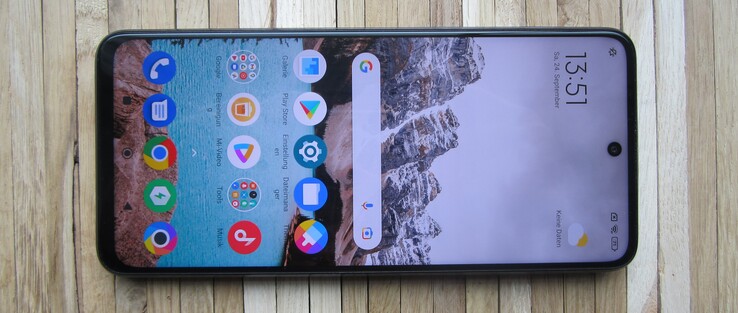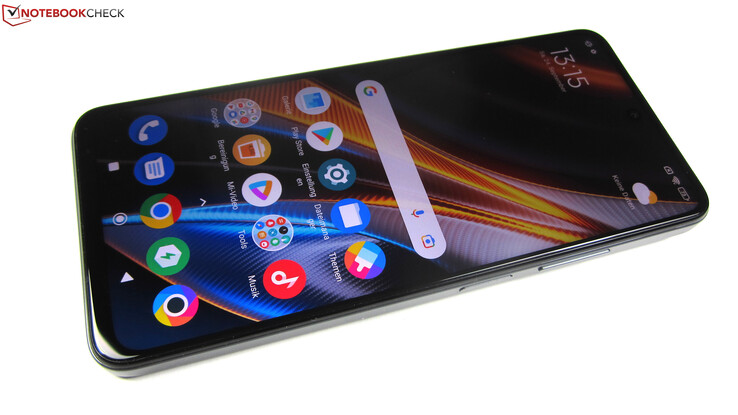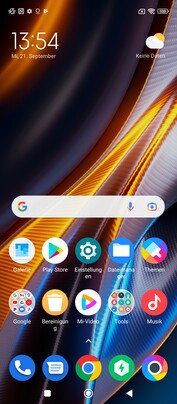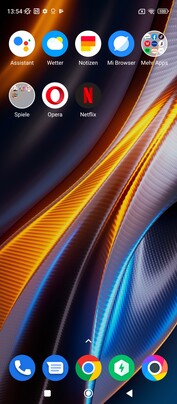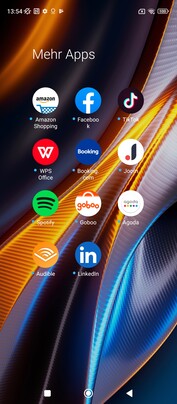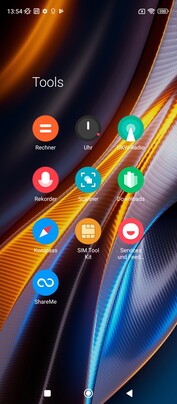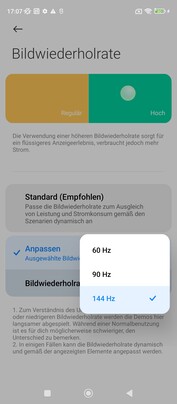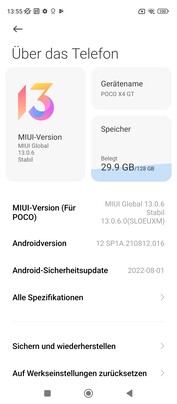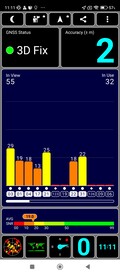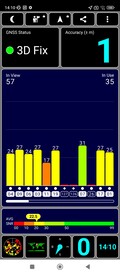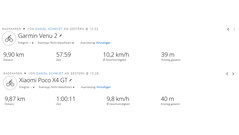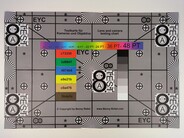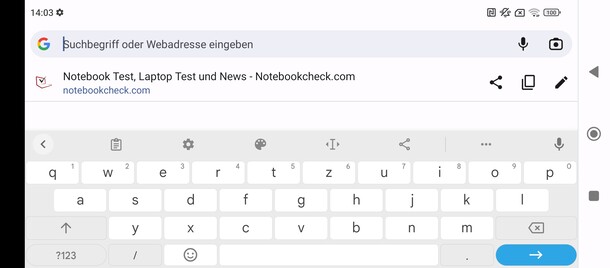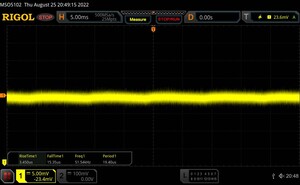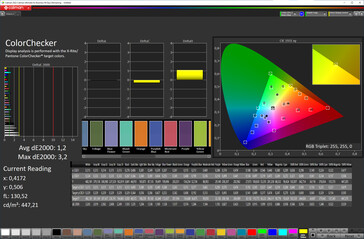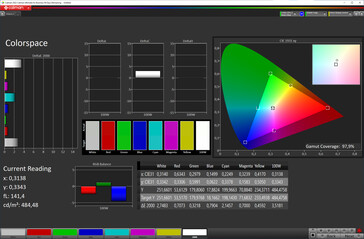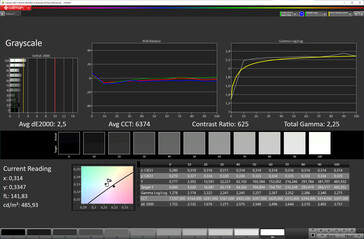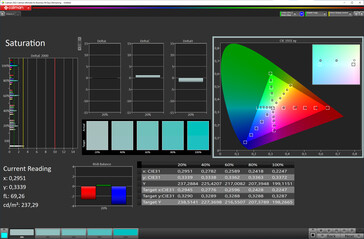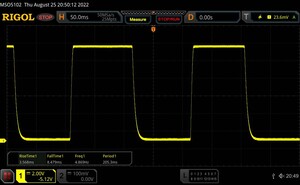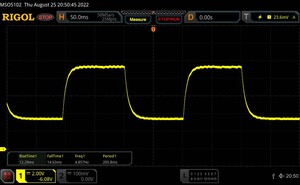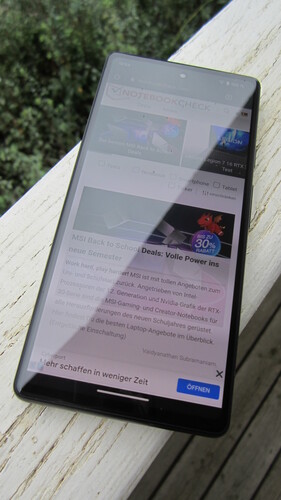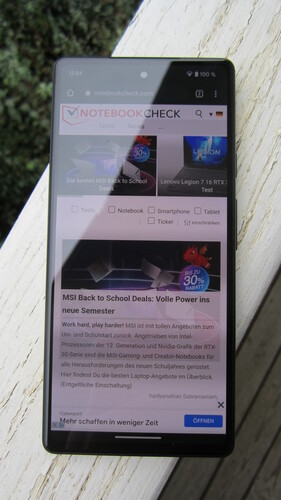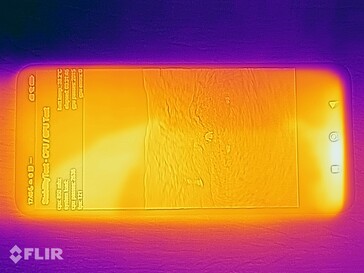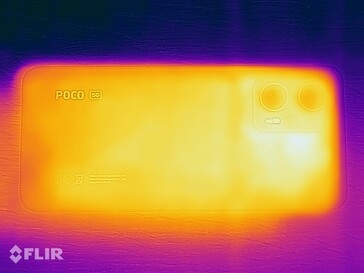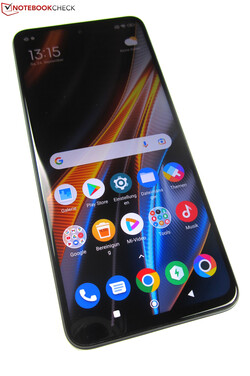Xiaomi Poco X4 GT smartphone review - Affordable high-performance phone with 144 Hz display
Xiaomi offers smartphones at different price ranges. The Mi series consists of expensive high-end phones, whilst more affordable models are offered under the Redmi brand. Then there is also the Poco line-up, which focuses even more on providing great specs at a budget price than Redmi phones. The Xiaomi Poco X4 GT is precisely one such example.
At its core, the 6.6-inch Poco X4 GT is powered by an eight-core MediaTek Dimensity 8100 processor paired with 8 GB of RAM and features a fast 144 Hz IPS panel. Under the hood, you will also find up to 256 GB of storage, a triple-camera setup with resolutions of up to 64 MP, support for the latest wireless standards (e.g. Wi-Fi 6) and fast charging with a 67-watt adapter. Read on to find out whether the Poco X4 GT has what it takes to best the competition in terms of value for money.
Comparison with possible competitors
Rating | Date | Model | Weight | Drive | Size | Resolution | Best Price |
|---|---|---|---|---|---|---|---|
| 85.6 % | 10/2022 | Xiaomi Poco X4 GT Dimensity 8100, Mali-G610 MP6 | 200 g | 128 GB UFS 3.1 Flash | 6.60" | 2460x1080 | |
| 85.8 % | 09/2022 | Google Pixel 6a Tensor, Mali-G78 MP20 | 178 g | 128 GB UFS 3.1 Flash | 6.10" | 2400x1080 | |
| 86.4 % | 07/2022 | Motorola Edge 30 SD 778G+ 5G, Adreno 642L | 155 g | 128 GB UFS 3.1 Flash | 6.50" | 2400x1080 | |
| 85.1 % | 08/2021 | OnePlus Nord 2 5G Dimensity 1200, Mali-G77 MP9 | 189 g | 256 GB UFS 3.1 Flash | 6.43" | 2400x1080 | |
| 83.4 % | 06/2022 | Samsung Galaxy A53 Exynos 1280, Mali-G68 MP4 | 189 g | 128 GB UFS 2.1 Flash | 6.50" | 2400x1080 | |
| 86.4 % | 09/2022 | Xiaomi Poco F4 SD 870, Adreno 650 | 195 g | 128 GB UFS 3.1 Flash | 6.67" | 2400x1080 |
Case - Matt plastic body
Xiaomi offers the Poco X4 GT in blue, silver and black. During our time with the phone, the matt back cover proved to be quite resistant to fingerprints. Once you slip the device into the included transparent protective case, it will stop rocking back and forth on a flat surface. Without the protective case, this is practically unavoidable because the camera bump protrudes around 3 mm (0.12") from the body.
The Poco X4 GT isn't exactly lightweight at 200 g (0.44 lb). Although the rear and the frame are made of plastic, the phone still feels nice and sturdy thanks to its great fit and finish and tight gaps. Only the middle of the back cover flexes very slightly without requiring too much force. However, this doesn't tarnish the overall feel of the phone. The Xiaomi phone isn't IP-certified. But the USB-C port can be sealed using the cap integrated into the protective case to prevent dust and dirt from entering the phone's body.
The front of the Poco X4 GT is protected by Gorilla Glass 5. The hole-punch selfie camera is located at the top of the IPS display. And the fingerprint sensor is built into the power button. Like the volume rocker, the power button sits firmly in the body, has almost no wiggle from side to side and is satisfying to press.
Features - 8 GB of RAM and up to 256 GB of storage
The Poco X4 GT comes in two storage options. The variant with 8 GB of LPDDR5 RAM and 128 GB of UFS 3.1 storage is officially priced at 380 Euro (around US$370), while the 8/256 GB model will set you back 430 Euro (around US$420).
Potential buyers should be aware that the phone doesn't have a microSD slot, a notification LED or an always-on display. But it does feature a 3.5-mm audio jack, an infrared transmitter and a pair of stereo speakers with Dolby Atmos certification. In addition to NFC and Bluetooth 5.3, the Poco X4 GT is also fitted with a USB-C port that supports OTG and runs at USB 2.0 speed.
Software - Android 12 and MIUI 13
The Poco X4 is running Android 12 with Xiaomi's own MIUI 13 user interface on top. In the course of our review, the smartphone received an update (MIUI 13.0.8.0) in late September that brought the device up to the latest security patch level dated 1 September 2022.
Right out of the box, about 98 GB of the 128 GB was usable on our review unit. The preinstalled third-party apps, such as Amazon, Facebook, Solitaire, Spotify and WPS Office, can all be deleted if you wish to free up some storage space. Because the Poco X4 GT supports Widevine L1 DRM, it is able to stream videos at HD quality.
Connectivity and GNSS - Fast Wi-Fi 6 and precise navigation
The Poco X4 has solid mobile connectivity with support for 12 frequency bands each in 4G and 5G networks. This level of compatibility is too low for the phone to be used worldwide, but at least it supports all frequencies relevant in the EU.
The Xiaomi phone is capable of using Wi-Fi 6, allowing it to reach transfer speeds that are excellent not just for a mid-range phone. When connected to our reference router (Asus ROG Rapture GT-AXE11000), the Poco X4 GT managed to hit speeds of up to 956 Mbit/s, making it almost as fast as the Google Pixel 6a. The Xiaomi Poco F4 is very close behind but performs slightly worse when it comes to receive rates. The Poco X4 GT is, however, not without its flaws: its data receive rates were not as stable as its data transmit rates.
| Networking | |
| iperf3 receive AXE11000 | |
| Google Pixel 6a | |
| Xiaomi Poco X4 GT | |
| Xiaomi Poco F4 | |
| Average of class Smartphone (34.8 - 1875, n=208, last 2 years) | |
| Samsung Galaxy A53 | |
| iperf3 transmit AXE11000 | |
| Xiaomi Poco F4 | |
| Xiaomi Poco X4 GT | |
| Google Pixel 6a | |
| Average of class Smartphone (40.5 - 1810, n=209, last 2 years) | |
| Samsung Galaxy A53 | |
| iperf3 transmit AXE11000 6GHz | |
| Average of class Smartphone (229 - 1894, n=61, last 2 years) | |
| Motorola Edge 30 | |
| iperf3 receive AXE11000 6GHz | |
| Average of class Smartphone (598 - 1840, n=61, last 2 years) | |
| Motorola Edge 30 | |
| iperf3 transmit AX12 | |
| OnePlus Nord 2 5G | |
| iperf3 receive AX12 | |
| OnePlus Nord 2 5G | |
| Average of class Smartphone (last 2 years) | |
For location tracking, the Poco X4 GT uses the satellite navigation services GPS (L1), Galileo (E1), Glonass (L1), QZSS (L1) and Beidou (B1). During our testing, the single-band GNSS took some time to locate us when we were inside buildings but produced relatively exact results with an accuracy of 2 m (6.56 ft). Outdoors, the Satfix was considerably faster and even accurate down to 1 m (3.28 ft).
In our real-world test, the Poco X4 GT provided us with accurate location information, proving that it is suitable for navigation purposes. On the approximately 10-km bike ride, the phone was able to map out the route almost as accurately as the Garmin Venu2 fitness smartwatch (brought along for comparison) apart from some minor deviations.
Telephony & voice quality
During calls, the Xiaomi phone delivered great voice quality. Voices sound crisp and clear on both ends of the line, even in hands-free mode. However, the phone isn't always able to reliably filter out loud ambient noises.
The Xiaomi Poco X4 can accommodate two nano SIM cards and supports both voice over LTE and voice over Wi-Fi.
Camera - Triple-camera setup with up to 64 MP
Typically, photography is not a top priority for Xiaomi's Poco smartphones, but the 64 MP triple-camera setup on the Poco X4 GT actually does its job pretty well. The same goes for the 16 MP selfie camera, which produces portraits that look decent but somewhat washed out.
The 64 MP main shooter on the phone uses the same Samsung GW1 sensor that, for instance, is also found on the realme GT Neo 2. This sensor groups four adjacent pixels into a larger pixel using a technique called binning.
Photos taken with the main camera in good lighting conditions stand out with crisp colours and a decent level of detail. However, photos shot in less-than-optimal lighting or darker areas of a scene have markedly lower contrast and sharpness. The 8 MP ultrawide camera also uses a Samsung sensor (Samsung S5K47H). It likewise takes solid pictures in good lighting, but photos end up having noticeably soft edges.
Because the phone lacks a telephoto lens, it is only able to take mediocre zoom shots that look unnatural due to the aggressive image sharpening. The main shooter wasn't able to cope with our low-light setup and only managed to produce a very blurry image of the Notebookcheck mascot. That said, you will still be able to get something usable out of dark scenes using Night mode. The Macro mode, which can be enabled in the camera settings, does a decent job. But you will get macro shots that are at least just as good using the zoom feature.
The main camera is able to record videos at up to 4K and 30 FPS and offers great image quality. However, the electronic image stabilisation only works up to 1080p, meaning you will need a really steady hand to capture usable 4K videos. Also, you can't switch between the main and ultrawide camera when recording videos.
Image Comparison
Choose a scene and navigate within the first image. One click changes the position on touchscreens. One click on the zoomed-in image opens the original in a new window. The first image shows the scaled photograph of the test device.
Daylight photo 1Daylight photo 2Ultrawide shot5X zoomLow-light photoIn the test lab, the main shooter was able to reproduce the colours on the ColorChecker card fairly accurately under optimal lighting conditions. The photo of the test chart also turned out impressively balanced. There is a noticeable reduction in sharpness towards the edges of the photo. However, this drawback is not specific to the Poco X4 GT as many other smartphone cameras also have this issue.


Accessories and warranty - 67-watt charger is included
Inside the box, you'll find a 67-watt charger, a USB cable (Type C to A), a SIM eject tool, a transparent protective case, a quick-start guide and a warranty card alongside the Poco X4 GT. The Xiaomi Store also sells various accessories, such as power banks or headphones, to go with the phone.
Xiaomi provides a 24-month warranty on the Poco X4 GT. The retailer's warranty also applies in addition.
Input devices and operation - Adaptive refresh rate of up to 144 Hz
The IPS display on the Poco X4 registers inputs very quickly and accurately. Thanks to the snappy MediaTek Dimensity 8100 and 8 GB of LPDDR5 RAM, the system is able to remain speedy even when many apps are opened at the same time.
When the "Standard" refresh rate setting is selected, the Poco X4 GT will dynamically adjust its screen refresh rate to a value from 30 to 144 Hz. Xiaomi calls this feature the "7-stage DynamicSwitch display", referring to the seven available refresh rates: 30, 48, 50, 60, 90, 120 and 144 Hz.
The screen refresh rate changes automatically based on what is on the screen. For example, the IPS panel can reduce its frequency to 30 Hz when playing back a video, and then increase its refresh rate to as high as 144 Hz during gaming or scrolling. The display's touch sampling rate can go up to 270 Hz when the refresh rate is 90 Hz or lower, which is also particularly useful when gaming.
For biometric authentication, the phone supports fingerprint and 2D face recognition. The fingerprint sensor is built into the power button. It detects fingerprints quickly without any noteworthy issues.
Display - IPS panel with HDR10 and Dolby Vision
The Poco X4 GT features a 2,460 x 1,080 IPS panel with an impressively high pixel density (407 PPI) and max refresh rate (up to 144 Hz). In the display settings, you can also manually set the refresh rate to 90 Hz or 60 Hz. The display also supports HDR10 and Dolby Vision. However, its peak brightness is slightly too low to provide an optimal HDR experience.
The IPS panel on the Xiaomi phone has an average peak brightness of 613.6 cd/m², which puts it in good company. Apart from the Xiaomi Poco F4, which has a much brighter screen, all the devices in our comparison delivered a similar level of peak brightness.
When the brightness measurement was limited to a smaller screen area (APL18), the panel managed to reach a brightness of 621 cd/m². The display brightness could go up to 525 cd/m² with the ambient light sensor disabled. At the lowest brightness setting, we measured a screen brightness of 1.71 cd/m²
We detected flicker on the IPS panel of the Poco X4 GT. However, at over 50,000 Hz, the PWM frequency is so high that even sensitive users shouldn't be affected by the flicker. Things are similar with temporal dithering. When examining the IPS panel using a microscope and slow-motion video capture (240 fps), we didn't notice any temporal dithering effects.
| |||||||||||||||||||||||||
Brightness Distribution: 94 %
Center on Battery: 629 cd/m²
Contrast: 1573:1 (Black: 0.4 cd/m²)
ΔE Color 1.2 | 0.5-29.43 Ø5
ΔE Greyscale 2.5 | 0.57-98 Ø5.3
97.9% sRGB (Calman 2D)
Gamma: 2.25
| Xiaomi Poco X4 GT IPS, 2460x1080, 6.60 | Google Pixel 6a AMOLED, 2400x1080, 6.10 | Motorola Edge 30 AMOLED, 2400x1080, 6.50 | OnePlus Nord 2 5G AMOLED, 2400x1080, 6.43 | Samsung Galaxy A53 AMOLED, 2400x1080, 6.50 | Xiaomi Poco F4 AMOLED, 2400x1080, 6.67 | |
|---|---|---|---|---|---|---|
| Screen | 21% | -5% | -48% | -3% | -12% | |
| Brightness middle | 629 | 758 21% | 632 0% | 594 -6% | 718 14% | 917 46% |
| Brightness | 614 | 767 25% | 630 3% | 594 -3% | 730 19% | 923 50% |
| Brightness Distribution | 94 | 93 -1% | 92 -2% | 99 5% | 92 -2% | 96 2% |
| Black Level * | 0.4 | |||||
| Contrast | 1573 | |||||
| Colorchecker dE 2000 * | 1.2 | 0.9 25% | 1.46 -22% | 2.74 -128% | 1.62 -35% | 2 -67% |
| Colorchecker dE 2000 max. * | 3.2 | 2.5 22% | 3.32 -4% | 6 -88% | 4.21 -32% | 5.2 -63% |
| Greyscale dE 2000 * | 2.5 | 1.6 36% | 2.6 -4% | 4.2 -68% | 2 20% | 3.5 -40% |
| Gamma | 2.25 98% | 2.2 100% | 2.209 100% | 2.278 97% | 2.156 102% | 2.23 99% |
| CCT | 6374 102% | 6599 98% | 6755 96% | 7322 89% | 6545 99% | 6447 101% |
* ... smaller is better
Screen Flickering / PWM (Pulse-Width Modulation)
| Screen flickering / PWM detected | 51540 Hz | ||
The display backlight flickers at 51540 Hz (worst case, e.g., utilizing PWM) . The frequency of 51540 Hz is quite high, so most users sensitive to PWM should not notice any flickering. In comparison: 53 % of all tested devices do not use PWM to dim the display. If PWM was detected, an average of 17933 (minimum: 5 - maximum: 3846000) Hz was measured. | |||
In the display settings, you can choose between the colour schemes "Vivid" (enabled by default), "Saturated" and "Original color". Due to its design, the IPS panel doesn't have a perfect black level, but its contrast ratio is nonetheless very respectable at 1,573:1. The same goes for image quality when the "Original color" mode is selected: colour values and shades of grey are within the ideal range (Delta E < 3), and the RGB balance is excellent at all brightness levels.
Display Response Times
| ↔ Response Time Black to White | ||
|---|---|---|
| 12.05 ms ... rise ↗ and fall ↘ combined | ↗ 3.568 ms rise | |
| ↘ 8.479 ms fall | ||
| The screen shows good response rates in our tests, but may be too slow for competitive gamers. In comparison, all tested devices range from 0.1 (minimum) to 240 (maximum) ms. » 28 % of all devices are better. This means that the measured response time is better than the average of all tested devices (21.5 ms). | ||
| ↔ Response Time 50% Grey to 80% Grey | ||
| 26.92 ms ... rise ↗ and fall ↘ combined | ↗ 12.29 ms rise | |
| ↘ 14.63 ms fall | ||
| The screen shows relatively slow response rates in our tests and may be too slow for gamers. In comparison, all tested devices range from 0.2 (minimum) to 636 (maximum) ms. » 31 % of all devices are better. This means that the measured response time is better than the average of all tested devices (33.8 ms). | ||
Because the screen's peak brightness is not all that high, you should probably avoid using the display in direct sunlight. Otherwise, you might not be able to make out much on the screen. In shady spots, however, the phone can be used outdoors without issues. Thanks to the wide viewing angle, contents on the screen remain easy to read even from a sharp angle.
Performance - Upper mid-range performance with the MediaTek 8100
The Poco X4 GT is powered by the high-end MediaTek Dimensity 8100 SoC. Although the eight-core ARM-based processor is not amongst the very best smartphone CPUs, it still offers performance that is in the upper mid-range.
In synthetic benchmarks, the Xiaomi delivered a similar level of performance to that of the Google Pixel 6a, which is equipped with the Tensor SoC. The only exception is that the MediaTek SoC was significantly slower than the Google CPU in the single-core benchmark. The Xiaomi Poco F4 (Snapdragon 870 5G) trails slightly behind the two phones. AnTuTu v9 gave the Poco X4 GT a respectable overall score of more than 800,000. On the other hand, the phone didn't handle the AI-related computations in AIMark well at all, but this is also the case with most of the other devices in our comparison.
| UL Procyon AI Inference for Android - Overall Score NNAPI | |
| Xiaomi Poco X4 GT | |
| Average MediaTek Dimensity 8100 (25609 - 27192, n=3) | |
| Average of class Smartphone (207 - 84787, n=149, last 2 years) | |
| OnePlus Nord 2 5G | |
| Google Pixel 6a | |
| Motorola Edge 30 | |
| Xiaomi Poco F4 | |
| Samsung Galaxy A53 | |
The Poco X4 GT features an ARM Mali-G610 MP6 integrated GPU. The Google Pixel 6a is its toughest competitor in 3D benchmarks. The Google phone achieved the best score in 3DMark Wild Life, whilst the Xiaomi phone reached the highest onscreen frame rate almost throughout GFXBench thanks to its 144 Hz display. Similarly, it is one of the best performers within the comparison group in GFXBench offscreen tests. The Poco X4 GT is too fast for some of the onscreen tests (such as 3DMark Sling Shot Extreme OpenGL ES 3.1), so we are not going to show any of the results here.
GFXBench (DX / GLBenchmark) 2.7: T-Rex Onscreen | 1920x1080 T-Rex Offscreen
GFXBench 3.0: on screen Manhattan Onscreen OGL | 1920x1080 1080p Manhattan Offscreen
GFXBench 3.1: on screen Manhattan ES 3.1 Onscreen | 1920x1080 Manhattan ES 3.1 Offscreen
GFXBench: on screen Car Chase Onscreen | 1920x1080 Car Chase Offscreen | on screen Aztec Ruins High Tier Onscreen | 2560x1440 Aztec Ruins High Tier Offscreen | on screen Aztec Ruins Normal Tier Onscreen | 1920x1080 Aztec Ruins Normal Tier Offscreen
| 3DMark / Wild Life Extreme Unlimited | |
| Google Pixel 6a | |
| Xiaomi Poco X4 GT | |
| OnePlus Nord 2 5G | |
| Xiaomi Poco F4 | |
| Motorola Edge 30 | |
| Samsung Galaxy A53 | |
| 3DMark / Wild Life Extreme | |
| Google Pixel 6a | |
| Xiaomi Poco X4 GT | |
| OnePlus Nord 2 5G | |
| Xiaomi Poco F4 | |
| Motorola Edge 30 | |
| Samsung Galaxy A53 | |
| 3DMark / Wild Life Unlimited Score | |
| Google Pixel 6a | |
| Xiaomi Poco X4 GT | |
| Xiaomi Poco F4 | |
| OnePlus Nord 2 5G | |
| Motorola Edge 30 | |
| Samsung Galaxy A53 | |
| 3DMark / Wild Life Score | |
| Google Pixel 6a | |
| Xiaomi Poco X4 GT | |
| Xiaomi Poco F4 | |
| OnePlus Nord 2 5G | |
| Motorola Edge 30 | |
| Samsung Galaxy A53 | |
| 3DMark / Sling Shot Extreme (ES 3.1) Unlimited Physics | |
| Xiaomi Poco X4 GT | |
| Motorola Edge 30 | |
| Google Pixel 6a | |
| Xiaomi Poco F4 | |
| Samsung Galaxy A53 | |
| 3DMark / Sling Shot Extreme (ES 3.1) Unlimited Graphics | |
| Xiaomi Poco F4 | |
| Xiaomi Poco X4 GT | |
| Google Pixel 6a | |
| Motorola Edge 30 | |
| Samsung Galaxy A53 | |
| 3DMark / Sling Shot Extreme (ES 3.1) Unlimited | |
| Xiaomi Poco X4 GT | |
| Xiaomi Poco F4 | |
| Google Pixel 6a | |
| Motorola Edge 30 | |
| Samsung Galaxy A53 | |
| GFXBench (DX / GLBenchmark) 2.7 / T-Rex Onscreen | |
| Xiaomi Poco X4 GT | |
| Motorola Edge 30 | |
| Samsung Galaxy A53 | |
| Xiaomi Poco F4 | |
| Google Pixel 6a | |
| OnePlus Nord 2 5G | |
| GFXBench (DX / GLBenchmark) 2.7 / T-Rex Offscreen | |
| Xiaomi Poco X4 GT | |
| Google Pixel 6a | |
| Xiaomi Poco F4 | |
| OnePlus Nord 2 5G | |
| Motorola Edge 30 | |
| Samsung Galaxy A53 | |
| GFXBench 3.0 / Manhattan Onscreen OGL | |
| Xiaomi Poco X4 GT | |
| Motorola Edge 30 | |
| OnePlus Nord 2 5G | |
| Google Pixel 6a | |
| Xiaomi Poco F4 | |
| Samsung Galaxy A53 | |
| GFXBench 3.0 / 1080p Manhattan Offscreen | |
| Google Pixel 6a | |
| Xiaomi Poco X4 GT | |
| OnePlus Nord 2 5G | |
| Xiaomi Poco F4 | |
| Motorola Edge 30 | |
| Samsung Galaxy A53 | |
| GFXBench 3.1 / Manhattan ES 3.1 Onscreen | |
| Xiaomi Poco X4 GT | |
| Motorola Edge 30 | |
| Google Pixel 6a | |
| Xiaomi Poco F4 | |
| OnePlus Nord 2 5G | |
| Samsung Galaxy A53 | |
| GFXBench 3.1 / Manhattan ES 3.1 Offscreen | |
| Google Pixel 6a | |
| Xiaomi Poco X4 GT | |
| OnePlus Nord 2 5G | |
| Xiaomi Poco F4 | |
| Motorola Edge 30 | |
| Samsung Galaxy A53 | |
| GFXBench / Car Chase Onscreen | |
| Google Pixel 6a | |
| Xiaomi Poco X4 GT | |
| Xiaomi Poco F4 | |
| OnePlus Nord 2 5G | |
| Motorola Edge 30 | |
| Samsung Galaxy A53 | |
| GFXBench / Car Chase Offscreen | |
| Xiaomi Poco X4 GT | |
| Google Pixel 6a | |
| Xiaomi Poco F4 | |
| OnePlus Nord 2 5G | |
| Motorola Edge 30 | |
| Samsung Galaxy A53 | |
| GFXBench / Aztec Ruins High Tier Onscreen | |
| Google Pixel 6a | |
| Xiaomi Poco X4 GT | |
| OnePlus Nord 2 5G | |
| Xiaomi Poco F4 | |
| Motorola Edge 30 | |
| Samsung Galaxy A53 | |
| GFXBench / Aztec Ruins High Tier Offscreen | |
| Google Pixel 6a | |
| Xiaomi Poco X4 GT | |
| Xiaomi Poco F4 | |
| OnePlus Nord 2 5G | |
| Motorola Edge 30 | |
| Samsung Galaxy A53 | |
| GFXBench / Aztec Ruins Normal Tier Onscreen | |
| Xiaomi Poco X4 GT | |
| Xiaomi Poco F4 | |
| OnePlus Nord 2 5G | |
| Google Pixel 6a | |
| Motorola Edge 30 | |
| Samsung Galaxy A53 | |
| GFXBench / Aztec Ruins Normal Tier Offscreen | |
| Xiaomi Poco X4 GT | |
| Xiaomi Poco F4 | |
| Google Pixel 6a | |
| OnePlus Nord 2 5G | |
| Motorola Edge 30 | |
| Samsung Galaxy A53 | |
The Poco X4 GT didn't break a sweat during the browser benchmarks. The Motorola Edge 30, Google Pixel 6a, Xiaomi Poco F4 and Xiaomi Poco X4 GT always occupied the top four spots in various browser benchmarks. In everyday use, the X4 GT offers very good web browsing performance. Websites load quickly and navigation is fast and smooth. There is no stuttering or lag even when many tabs are kept open at the same time.
| Jetstream 2 - Total Score | |
| Average of class Smartphone (13.8 - 351, n=172, last 2 years) | |
| Xiaomi Poco F4 (Edge 105) | |
| Motorola Edge 30 (Chrome 102.0.5005.125) | |
| Xiaomi Poco X4 GT (Mi Browser 13.14.1-gn) | |
| Average MediaTek Dimensity 8100 (80.5 - 82.5, n=3) | |
| Google Pixel 6a (Firefox 1ß4-2-ß) | |
| Samsung Galaxy A53 (Chrome 101) | |
| OnePlus Nord 2 5G (Chrome 92) | |
| Speedometer 2.0 - Result | |
| Average of class Smartphone (14.9 - 445, n=157, last 2 years) | |
| Google Pixel 6a (Chrome 105.0.5195.79) | |
| Xiaomi Poco X4 GT (79.Chrome 105.0.5195.136) | |
| Average MediaTek Dimensity 8100 (64.5 - 79.3, n=3) | |
| Motorola Edge 30 (Chrome 102.0.5005.125) | |
| Xiaomi Poco F4 (Edge 105) | |
| Samsung Galaxy A53 (Chome 101) | |
| OnePlus Nord 2 5G (Chome 92) | |
| WebXPRT 4 - Overall | |
| Average of class Smartphone (22 - 202, n=159, last 2 years) | |
| Xiaomi Poco X4 GT (Chrome 105.0.5195.136) | |
| Motorola Edge 30 (Chrome 102.0.5005.125) | |
| Average MediaTek Dimensity 8100 (79 - 94, n=2) | |
| Google Pixel 6a (Chrome 105.0.5195.79) | |
| Xiaomi Poco F4 (Chrome 103) | |
| WebXPRT 3 - Overall | |
| Average of class Smartphone (39 - 304, n=122, last 2 years) | |
| Motorola Edge 30 (Chrome 102.0.5005.125) | |
| Average MediaTek Dimensity 8100 (101 - 113, n=3) | |
| Xiaomi Poco X4 GT (Chrome 105.0.5195.136) | |
| Xiaomi Poco F4 (chrome 103) | |
| Google Pixel 6a (Chrome 105.0.5195.79) | |
| OnePlus Nord 2 5G (Chrome 92) | |
| Samsung Galaxy A53 (Chrome 101) | |
| Octane V2 - Total Score | |
| Xiaomi Poco F4 (Edge 105) | |
| Average MediaTek Dimensity 8100 (33046 - 35255, n=3) | |
| Average of class Smartphone (4633 - 89112, n=210, last 2 years) | |
| Google Pixel 6a (Chrome 105.0.5195.79) | |
| Xiaomi Poco X4 GT (Chrome) | |
| Motorola Edge 30 (Chrome 102.0.5005.125) | |
| OnePlus Nord 2 5G (Chrome 92) | |
| Samsung Galaxy A53 (Chrome 101) | |
| Mozilla Kraken 1.1 - Total | |
| Samsung Galaxy A53 (Chrome 101) | |
| OnePlus Nord 2 5G (Chrome 92) | |
| Xiaomi Poco F4 (chrome 103) | |
| Average of class Smartphone (388 - 9999, n=172, last 2 years) | |
| Google Pixel 6a (Chrome 105.0.5195.79) | |
| Average MediaTek Dimensity 8100 (1274 - 1447, n=3) | |
| Motorola Edge 30 (Chrome 102.0.5005.125) | |
| Xiaomi Poco X4 GT (Chrome 105.0.5195.136) | |
* ... smaller is better
The fast UFS 3.1 storage helps the Xiaomi Poco X4 GT achieve excellent read and write speeds. This is, among other things, evident in the very short loading times of apps. The device's 4K random read and write speeds are also much higher than average.
| Xiaomi Poco X4 GT | Google Pixel 6a | Motorola Edge 30 | OnePlus Nord 2 5G | Samsung Galaxy A53 | Xiaomi Poco F4 | Average 128 GB UFS 3.1 Flash | Average of class Smartphone | |
|---|---|---|---|---|---|---|---|---|
| AndroBench 3-5 | -43% | -33% | -25% | -59% | -46% | -36% | -29% | |
| Sequential Read 256KB | 1877.54 | 1312.64 -30% | 1514.62 -19% | 1827 -3% | 510.1 -73% | 1371.56 -27% | 1599 ? -15% | 1505 ? -20% |
| Sequential Write 256KB | 1283.77 | 712.94 -44% | 965.35 -25% | 1256 -2% | 486.7 -62% | 701.06 -45% | 777 ? -39% | 1112 ? -13% |
| Random Read 4KB | 389.91 | 219.53 -44% | 241.72 -38% | 223.7 -43% | 229.9 -41% | 183.61 -53% | 244 ? -37% | 247 ? -37% |
| Random Write 4KB | 502.96 | 225.61 -55% | 249.14 -50% | 239 -52% | 210.8 -58% | 200.41 -60% | 245 ? -51% | 271 ? -46% |
Gaming - Smooth gameplay even at max settings
The MediaTek Dimensity 8100 and its ARM Mali-G610 MP6 integrated GPU make the Poco X4 GT a powerful phone for gaming. Games with simple graphics like Subway Surfers and Armajet run consistently at high frame rates. A much more demanding title such as PUBG Mobile also plays smoothly at the highest settings. You can definitely get frame rates above 30 FPS at "HD/High" settings, but the phone doesn't allow anything more than that – probably to limit power usage. In PUBG Mobile, "HDR/Extreme" is the highest settings you can choose on the phone.
We measured the in-game frame rates using GameBench.
Emissions - Stays cool even under load
Temperature
Surface temperatures on the Poco X4 GT stayed within an acceptable range and didn't exceed 35.1°C (95.2°F). Even under load, temperatures in the centre only increased to 34°C (93.2°F), meaning the phone is at most warm to the touch and will always be comfortable to hold in the hand.
As shown by the 3DMark Wild Life stress test, the phone may experience throttling when running loads. That said, it took quite a few runs of the benchmark before the SoC switched to a lower clock speed. In practice, though, you probably won't notice it because the phone still offers enough performance to handle all kinds of day-to-day tasks despite the reduced CPU power.
(+) The maximum temperature on the upper side is 35.1 °C / 95 F, compared to the average of 35 °C / 95 F, ranging from 21.9 to 56 °C for the class Smartphone.
(+) The bottom heats up to a maximum of 34.5 °C / 94 F, compared to the average of 33.8 °C / 93 F
(+) In idle usage, the average temperature for the upper side is 29 °C / 84 F, compared to the device average of 32.7 °C / 91 F.
3DMark Wild Life Stress Test
| 3DMark | |
| Wild Life Stress Test Stability | |
| Samsung Galaxy A53 | |
| Motorola Edge 30 | |
| Xiaomi Poco F4 | |
| Xiaomi Poco X4 GT | |
| OnePlus Nord 2 5G | |
| Google Pixel 6a | |
| Wild Life Extreme Stress Test | |
| Motorola Edge 30 | |
| Samsung Galaxy A53 | |
| Xiaomi Poco F4 | |
| Xiaomi Poco X4 GT | |
| OnePlus Nord 2 5G | |
| Google Pixel 6a | |
Speakers
The stereo speakers are located on the two short sides of the Poco X4 GT. They support Dolby Atmos and can get fairly loud at 86.1 dB(A) without any distortion. The mids and highs produced by the speakers sound very balanced, but you will be hard-pressed to find any bass at all.
There is a 3.5-mm audio jack for connecting the Poco X4 GT to wired audio devices. It has a good signal-to-noise ratio of 88.4 dBFS. The phone can also connect to wireless devices via Bluetooth 5.3 and supports common audio codecs such as AAC, SBC, LDAC, aptX HD, aptX Adaptive Audio and aptX TWS+.
Xiaomi Poco X4 GT audio analysis
(+) | speakers can play relatively loud (86.1 dB)
Bass 100 - 315 Hz
(-) | nearly no bass - on average 25.3% lower than median
(±) | linearity of bass is average (11.7% delta to prev. frequency)
Mids 400 - 2000 Hz
(+) | balanced mids - only 4% away from median
(+) | mids are linear (3.7% delta to prev. frequency)
Highs 2 - 16 kHz
(+) | balanced highs - only 4.7% away from median
(+) | highs are linear (5.4% delta to prev. frequency)
Overall 100 - 16.000 Hz
(±) | linearity of overall sound is average (17.8% difference to median)
Compared to same class
» 10% of all tested devices in this class were better, 7% similar, 83% worse
» The best had a delta of 12%, average was 38%, worst was 134%
Compared to all devices tested
» 30% of all tested devices were better, 8% similar, 62% worse
» The best had a delta of 4%, average was 25%, worst was 134%
Samsung Galaxy A53 audio analysis
(+) | speakers can play relatively loud (86.1 dB)
Bass 100 - 315 Hz
(-) | nearly no bass - on average 25.7% lower than median
(±) | linearity of bass is average (11.2% delta to prev. frequency)
Mids 400 - 2000 Hz
(±) | higher mids - on average 8.4% higher than median
(±) | linearity of mids is average (7.1% delta to prev. frequency)
Highs 2 - 16 kHz
(±) | higher highs - on average 5.3% higher than median
(+) | highs are linear (6.7% delta to prev. frequency)
Overall 100 - 16.000 Hz
(±) | linearity of overall sound is average (24.1% difference to median)
Compared to same class
» 50% of all tested devices in this class were better, 8% similar, 42% worse
» The best had a delta of 12%, average was 38%, worst was 134%
Compared to all devices tested
» 68% of all tested devices were better, 7% similar, 25% worse
» The best had a delta of 4%, average was 25%, worst was 134%
Battery life - Fast charge in an hour
Power consumption
Xiaomi has included a 67-watt charger with the phone. During our testing, the Poco X4 GT was able to fully charge within 59 minutes using the charger provided. It took around 40 minutes for the battery to get from zero to 80 per cent. Unfortunately, the phone doesn't support wireless charging.
The Poco X4 GT isn't very impressive when it comes to power consumption. It used considerably more power than the other devices in the comparison, especially at idle, and wasn't very efficient under load either.
| Off / Standby | |
| Idle | |
| Load |
|
| Xiaomi Poco X4 GT 5080 mAh | Google Pixel 6a 4410 mAh | Motorola Edge 30 4020 mAh | OnePlus Nord 2 5G 4500 mAh | Samsung Galaxy A53 5000 mAh | Xiaomi Poco F4 4500 mAh | Average MediaTek Dimensity 8100 | Average of class Smartphone | |
|---|---|---|---|---|---|---|---|---|
| Power Consumption | 5% | 16% | -1% | 4% | 19% | -2% | 1% | |
| Idle Minimum * | 0.78 | 0.68 13% | 0.9 -15% | 0.8 -3% | 0.9 -15% | 0.8 -3% | 1.087 ? -39% | 0.897 ? -15% |
| Idle Average * | 1.98 | 1.56 21% | 1.2 39% | 1.2 39% | 1.3 34% | 1.29 35% | 1.77 ? 11% | 1.452 ? 27% |
| Idle Maximum * | 2.01 | 1.58 21% | 1.5 25% | 1.6 20% | 1.6 20% | 1.38 31% | 2 ? -0% | 1.629 ? 19% |
| Load Average * | 4.43 | 5.37 -21% | 3.6 19% | 5.7 -29% | 5.7 -29% | 3.78 15% | 3.82 ? 14% | 5.55 ? -25% |
| Load Maximum * | 8.2 | 8.74 -7% | 7.1 13% | 10.9 -33% | 7.3 11% | 6.71 18% | 7.9 ? 4% | 8.31 ? -1% |
* ... smaller is better
Power consumption: Geekbench (150 cd/m²)
Power consumption: GFXBench (150 cd/m²)
Battery life
The 5080 mAh battery gives the Xiaomi Poco X4 GT great battery life. The device ran for almost 15.5 hours during our test designed to simulate web browsing (screen brightness adjusted to 150 cd/m²; using a script to access different websites every 30 seconds). Battery life increased to almost 18 hours during video playback.
Overall, the Poco X4 GT has a longer battery life than nearly all the other devices in the comparison. Only the Google Pixel 6a lasted marginally longer when all the battery test scenarios are taken as a whole. The Xiaomi phone should have no problem making it through a day without charging.
| Xiaomi Poco X4 GT 5080 mAh | Google Pixel 6a 4410 mAh | Motorola Edge 30 4020 mAh | OnePlus Nord 2 5G 4500 mAh | Samsung Galaxy A53 5000 mAh | Xiaomi Poco F4 4500 mAh | |
|---|---|---|---|---|---|---|
| Battery Runtime | 1% | -21% | -6% | -5% | -26% | |
| Reader / Idle | 2552 | 1878 -26% | 1604 -37% | 1926 -25% | 2431 -5% | 1342 -47% |
| H.264 | 1065 | 1318 24% | 1002 -6% | 1126 6% | 1146 8% | 929 -13% |
| WiFi v1.3 | 929 | 768 -17% | 638 -31% | 958 3% | 886 -5% | 665 -28% |
| Load | 295 | 360 22% | 268 -9% | 272 -8% | 246 -17% | 246 -17% |
Pros
Cons
Verdict on the Xiaomi Poco X4 GT
The Xiaomi Poco X4 GT is a great mid-range smartphone that offers more than enough performance for everyday use and doesn't break a sweat when multitasking or handling demanding games. Furthermore, it is very smooth to use thanks to its adaptive 144 Hz display. You'll have to make do with a plastic phone body, but the device looks great and is well put together.
In typical Poco fashion, the rest of the phone is likewise packed with features. Besides a pair of stereo speakers, there is a 3.5-mm audio jack. The phone also supports current wireless standards with its Wi-Fi 6 and Bluetooth 5.3 capabilities. The 64 MP camera does its job well and produces respectable images under optimal lighting conditions. The great overall package is topped off by the included accessories, namely a protective case and a 67-watt charger.
A fast processor, a 144 Hz display, a large battery and fast charging – the Xiaomi Poco X4 GT offers great value for its official price tag of 380 Euro.
But the Poco X4 GT is not without its drawbacks. Our main complaint: the IPS display. While it is very respectable, many other phones in the same price range are already sporting an AMOLED panel. This also makes the phone a tougher sell. For instance, the Xiaomi Poco F4 is roughly as fast and not much more expensive, but offers a considerably brighter OLED screen.
Other than the Poco F4, alternatives to the Xiaomi Poco X4 GT include the Google Pixel 6a, Motorola Edge 30 and Samsung Galaxy A53.
Price and availability
At the time of this review, the Xiaomi Poco X4 GT with 8 GB or RAM and 128 GB of storage costs around US$328 from retailers such as Amazon.com. There model with more storage (256 GB) is priced at US$374.
Xiaomi Poco X4 GT
-
10/10/2022 v7
Manuel Masiero


 Deutsch
Deutsch English
English Español
Español Français
Français Italiano
Italiano Nederlands
Nederlands Polski
Polski Português
Português Русский
Русский Türkçe
Türkçe Svenska
Svenska Chinese
Chinese Magyar
Magyar